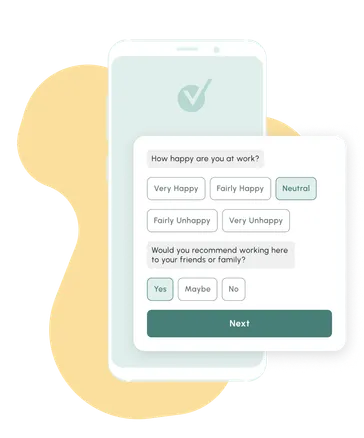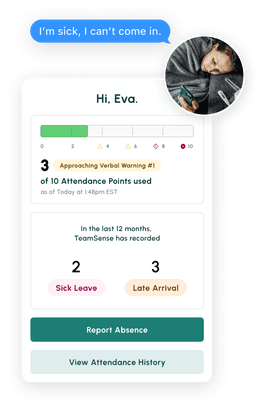When to HR with AI (and When Not To)!
Table of Contents
- What is considered a no call no show at work?
- Exploring the Employee's Perspective: Why No Call No Shows Happen
- How to Address No Call No Shows
- Streamlining the Call-Out Process: The #1 Way To Reduce No Call No Shows
- The Importance of an Easy Reporting System
- 10 Other Ways to Reduce Employee No Call No Show
- 1. Have a Clear Attendance Policy
- 2. Improve Open Communication
- 3. Make Sure Every Employee Knows Their Shift
- 4. Encourage Your Team to Use PTO
- 5. Support Employee Wellness and Mental Health to Avoid Burnout
- 6. Boost Employee Engagement
- 7. Create a Healthy Company Culture
- 8. Be Consistent with Policy
- 9. Consider Flexible Schedules
- 10. Again, Don’t Make Calling Out Complicated
- Let Your Employees Call Out with Text
Is your company noticing a higher rate of no call no shows lately? Don’t worry—you’re not alone. According to the Bureau of Labor Statistics, the average absence rate in America is 3.6%.1 On top of that, in 2022, there were over 2 million Google searches for "excuses to miss work." That's up from around 300,000 in 2018.2 Now, of course, you’re going to have absent employees sometimes, but employees who don’t call out ahead of time can cause your company’s productivity and employee morale to go down.
No call no shows can really throw a wrench in your workflow. And whatever term your company uses for it—employees not showing up for work and not telling you about it is a problem. Let’s dig into how to handle this kind of absenteeism with 10 ways to reduce no shows at your company.
What is considered a no call no show at work?
A "no call no show" at work is typically defined as a situation where an employee fails to show up for their scheduled shift and does not communicate their absence to a supervisor or manager in advance. This kind of absence is usually considered unexcused and can disrupt the workflow of the organization, potentially leading to a loss of revenue and productivity for the company.
The specifics of what constitutes a no call no show can vary between organizations, depending on their policies and procedures. Some companies may define a no call no show as not reporting to work and not informing a manager at least one hour before the scheduled start time, while others might have a different time frame or procedure for reporting absences.
It's important for both employers and employees to clearly understand and adhere to the specific no call no show policy outlined by their company. This policy usually describes the process for reporting absences, the consequences of failing to do so, and how the company handles repeated incidents.
Understanding the legal framework for no call no shows
Navigating the legal landscape of no call no shows is essential for both employers and employees to ensure compliance with labor laws and to understand their rights and responsibilities. This section highlights key legal aspects and considerations.
Employment Contracts and Company Policies
The legal standing of a no call no show situation often depends on the specific terms of the employment contract and the company's attendance policy. Employers must clearly define and communicate the terms regarding absenteeism and the consequences of no call no shows in their policy handbooks.
At-Will Employment Considerations
In many regions, particularly in the United States, employment is often "at-will," meaning either the employer or the employee can terminate the employment relationship at any time, for any reason. However, this does not exempt employers from fair practice obligations.
Compliance with Federal and State Laws
Employers need to be mindful of various federal and state laws that may impact how they handle no call no shows. For instance, the Family Medical Leave Act (FMLA) and the Americans with Disabilities Act (ADA) provide protections for employees under certain circumstances, which might excuse their absence.
Protected Leaves
Certain absences might be protected under law, such as those related to medical reasons, disability, or family emergencies. Employers must consider these factors before taking disciplinary action against a no call no show incident to avoid legal repercussions.
Discrimination and Wrongful Termination Claims
Employers must apply their no call no show policies uniformly to all employees to avoid discrimination claims by other employees. Any disciplinary action taken should be consistent with how other similar situations have been handled to prevent claims of wrongful termination.
Documentation and Record-Keeping
Maintaining accurate records of employee attendance, including no call no shows, and any communication related to these incidents is crucial. These records can be vital in case of any legal disputes or claims.
Seeking Legal Counsel
For complex situations or when in doubt, it's advisable for employers to seek legal counsel to ensure their policies and actions are in compliance with current employment laws. This is especially important as employment laws can vary significantly from one region to another.
By understanding and adhering to the legal framework surrounding no call no shows, employers can manage these situations fairly and legally, while employees can be aware of their rights and the potential consequences of their actions.

Exploring the Employee's Perspective: Why No Call No Shows Happen
Understanding why employees engage in no call no show behavior is crucial in developing effective strategies to mitigate this issue. This section delves into the various reasons that might lead an employee to miss work without prior notice or notification.
Personal Emergencies and Unforeseen Circumstances
Sometimes, employees face urgent personal situations such as a family emergency or a sudden health issue that prevent them from notifying their absence in advance. Recognizing and empathizing with these unforeseen circumstances can help in fostering a supportive work environment.
Mental Health and Stress
Mental health issues and workplace stress are significant factors that can lead to absenteeism. Employees struggling with these issues might find it challenging to communicate their need for a break, resulting in no call no show incidents.
Workplace Environment and Culture
The workplace culture plays a pivotal role in employee attendance. A toxic or overly stressful work environment can discourage employees from showing up or communicating their absences. Conversely, a positive and supportive culture can encourage better communication and attendance.
Miscommunication or Lack of Awareness
Sometimes, no call no shows stem from misunderstandings or a lack of awareness about zero tolerance policy and the proper procedures for reporting absences. Ensuring that all employees are aware of and understand the attendance policy is essential.
Job Dissatisfaction and Disengagement
Employees who are dissatisfied with their job or feel disengaged are more likely to miss work without notice. Factors contributing to job dissatisfaction could include lack of recognition, limited growth opportunities, or poor management practices.
Transportation and Logistic Challenges
For some employees, unexpected transportation issues such as car breakdowns or public transport delays can lead to absenteeism. Addressing these logistic challenges can be a part of the solution.
Balancing Work and Personal Life
In today's fast-paced world, balancing work and personal life is increasingly challenging. Employees may find themselves unable to attend work due to personal responsibilities, especially if they feel the workplace does not accommodate their work-life balance needs.
Fear of Repercussions
Fear of negative repercussions or not feeling comfortable enough to communicate with supervisors can also lead to no call no show situations. Creating an environment where employees feel safe to discuss their challenges can mitigate this issue.
In addressing no call no shows, it is important for employers to consider these diverse factors. By understanding the root causes from the employee's perspective, organizations can develop more empathetic and effective policies and interventions to reduce the occurrence of such incidents.
How to Address No Call No Shows
At every company, the process of how to deal with no call no shows will look different. But in general, here are five easy steps you can follow to deal with no call no shows at your company.
1. Talk with your employee.
When the employee returns to work, schedule a meeting with them right away. Don’t delay and kick the problem further down the road. Take the time to talk with your employee ASAP.
2. Find out what happened.
Here’s where you need to gather all the details first-hand from your employee. You might have jumped to the conclusion that they just overslept when they didn’t show up, when they were really taking care of a family medical emergency first. You’ll never know until you ask the employee exactly why they didn’t show up for work.
3. Follow your no call no show policy.
Once you have a clear sense of what happened, you can follow your company no call no show policy (now that you have all the details). If it’s a first offense, you might just need to give a verbal warning or written warning to your employee. But if this has happened before, you’ll likely need to issue some consequences to your employee.
4. Communicate consequences.
Whatever you do, be sure your disciplinary actions line up with the no call no show policy in your company and employee handbook (told you you’d want to have this). With a clear no show no call policy in place, you won’t have to wonder what consequences to give, because they will be laid out clearly for you already.
Be sure you follow everything fairly across the board to each employee. Never show favoritism to one employee over another. If you follow the company policy the same way every time, you’ll never have to worry about it.
5. Set future expectations.
Don’t forget to clearly set attendance rules, policy rules and expectations for the future here too. Depending on how many times the employee has done this before will impact this.
If this is their third offense in the last six months and the fourth offense equals a termination letter, be upfront and clearly communicate that. The last thing you want is for your team member to walk away without realizing how serious the next set of consequences will be if they don’t change their behavior.
Streamlining the Call-Out Process: The #1 Way To Reduce No Call No Shows
Streamlining the call-out process is widely recognized as a crucial strategy in reducing no call no shows in the workplace. Simplifying how employees report absences can significantly impact overall attendance rates and workplace efficiency.

The Importance of an Easy Reporting System
An intricate or time-consuming call-out process can be a deterrent for employees to report their absences. When the process is made easier, employees are more likely to comply with attendance policies. This ease of reporting is crucial in fast-paced work environments where immediate notification of absence is essential.
How Technology Facilitates Streamlined Call-Outs
Technological solutions, like TeamSense, play a pivotal role in modernizing the call-out process. TeamSense, for instance, offers a text message-based system that allows employees to report absences quickly and easily. This method is particularly effective as it aligns with the everyday communication habits of most employees.
Impact on Absenteeism: A Case in Point
Implementing a system like TeamSense can have a substantial impact. For example, integrating a straightforward, text-based system has been shown to reduce employee absenteeism significantly, as seen in some case studies. In one such case, absenteeism was reduced by 39% following the implementation of TeamSense. This reduction not only demonstrates the effectiveness of a simplified call-out process but also highlights the importance of adopting user-friendly technology.
Benefits Beyond Reducing Absenteeism
Streamlining the call-out process with tools like TeamSense offers several advantages:
- Quick Adaptation to Staffing Needs: Managers receive immediate notifications of absences, allowing for faster adjustments to staffing.
- Accurate Record-Keeping: Automated systems provide a reliable record of absences, which is essential for policy compliance and potential legal considerations.
- Enhanced Employee Experience: A user-friendly system improves the overall experience for employees, making them feel more valued and respected.
Building a Culture of Accountability and Transparency
By making it easier for employees to report their absences, companies foster a culture of accountability. Employees are more likely to follow procedures when they are simple and clear. Moreover, such systems promote transparency in the workplace, enhancing trust between employees and management.
In summary, optimizing the call-out process is a key element in reducing no call no shows. Tools like TeamSense, with their emphasis on simplicity and efficiency, support this goal and can lead to a more cohesive and productive work environment. Employers looking to reduce absenteeism should consider the significant benefits of streamlining their absence reporting processes.
10 Other Ways to Reduce Employee No Call No Show
So how can you cut back on no call no shows from happening in the future? It might sound like a nice fairytale, but it doesn’t have to be that way. The truth is, there are plenty of steps you can take to make sure that your team lets you know when they’ll be absent. Here are 10 practical tips to reduce no call no shows from happening at your company.
1. Have a Clear Attendance Policy
Yeah, we probably sound like a broken record at this point, but we can’t stress this one enough. Having a clear policy when it comes to no show no calls will let your team know exactly what will happen if they skip work (and don't tell their supervisor about it). This policy is the foundation you need to help reduce no call no shows from happening at your company.
2. Improve Open Communication
Your leaders and managers should constantly prioritize having open communication with their direct reports. When management and their team can trust one another, it makes for a better working environment and boosts morale within the team.
And here’s a bonus: If there is trust, all your employees will be more likely to notify you if they can’t make it to work that day. So focus on developing trust and mutual respect with each of your direct reports—the benefits are well worth it.
3. Make Sure Every Employee Knows Their Shift
This one might sound silly, but you’d be surprised how many employees get their shift schedule confused sometimes—especially if they are working constantly changing shifts. Two great ways to keep your team on the same page? Use an online shift schedule that employees can view anytime and message your team if their schedule changes.
4. Encourage Your Team to Use PTO
Paid vacation time is there for a reason. Whether your employees are taking a week-long vacation to the beach or just need a mental health day, paid time off is there when they need it. Encourage existing and new employees on your team not to let too much time build up before they take a break. After all, you don’t want a bunch of overworked employees on your hands.
5. Support Employee Wellness and Mental Health to Avoid Burnout
Employee burnout has become an ongoing workplace issue, especially in the years since the pandemic, with 52% of employees saying they feel burned out.3 With employee burnout rates so high, employers should be doing everything they can to support their team with wellness and mental health benefits.
And guess what? That effort goes a long way. In fact, 91% of employees believe a company’s culture should support mental health.4 By supporting your human resource management and resources team to take action against employee burnout, you could reduce no call no show rates and retention rates overall.
6. Boost Employee Engagement
Did you know employees who are more engaged at work are less likely to be absent? It’s true, a high level of employee engagement can reduce employee's absence and absenteeism costs by as much as 81%.5 So ask yourself what your company can do to increase employee engagement? It could be as simple as taking the time to send out engagement surveys to help employees make their voices heard, or as involved as starting special interest groups for your team to connect.

7. Create a Healthy Company Culture
When you have a solid company culture, your team will be more likely to show up to work. Why? Because it’s a place they actually enjoy being at. Now, it goes without saying that you could have a great company culture and still end up with no call no shows. But you should still work toward creating an excellent company culture your team wants to be a part of.
8. Be Consistent with Policy
Wherever you land with your no call no show absence policy, be sure that it is applied fairly across the board to every employee. The last thing you want is claims that you are being unfair or singling out employees. When your team sees that the rules apply to employees equally to everyone, they will be more likely to take your policy seriously.
9. Consider Flexible Schedules
Having no call no shows can be a sign that your employees might need more flexibility when it comes to their schedules. For some companies, that might mean offering remote or hybrid working situations. And for other companies, that could mean offering flexible working hours or scheduling practices that support a better work-life balance.
10. Again, Don’t Make Calling Out Complicated
If your company’s call out process is complicated and requires a lot of effort, be prepared for plenty of no shows and no calls when it comes to absent team members. If an absent employee is sick or can’t make it in at a moment’s notice, odds are they don’t want to fill out five pages of paperwork and call two different supervisors at 5:00 a.m. Truth is, they’d probably rather take the write-up than go through your 12-step call out process.
Make it easier on everybody with a simple, straightforward, easy to remember call out process. The simplest way to do it? Use text messages to call out. It removes the friction for them and means you’ll get fewer no shows.
Let Your Employees Call Out with Text
If you really want to reduce no call no shows, it’s time to make it simpler for your team when they need to call out for the day. Absence management can be complicated, but TeamSense makes it simple.
With text messages, your team can easily communicate their absence—no technology gaps or fancy apps needed. Get started with the only absence management solution you need. It’s time to cut back on no call no shows and make it easier than ever for your team to keep you in the loop.

Is your call-in process terrible? Text reduces no-shows and absenteeism by up to 40%.
Don't believe us? Check out this case study to see how this 3PL benefited.
About the Author

Sheila Stafford, CEO of TeamSense & AI in HR Innovator
As CEO of TeamSense, Sheila Stafford is at the forefront of transforming HR for frontline teams through AI-driven solutions. With a commitment to enhancing employee relations and simplifying workforce management, Sheila leads TeamSense in pioneering advancements that empower both frontline employees and HR teams. Her visionary approach combines cutting-edge technology with a thoughtful focus on enhancing human connection; Sheila strategically implements AI where it adds the most value while recognizing the critical role of personal interaction and ensuring that human engagement remains central when it matters most. Under her leadership, TeamSense is redefining how companies support and engage their frontline teams for a more connected, efficient workplace.





